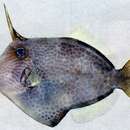Diagnostic Description
provided by Fishbase
Can adopt three basic color patterns: mottled grey and brown, dark brown, or grey with a network of close-set polygonal spots. All have a small white spot at the rear base of the second dorsal fin and sometimes the anal fin.Description: Characterized further by first dorsal spine nearly equal to length of snout, above front half of eye and partially fitting into groove on back; side of caudal peduncle with dense patch of setae in adult male; concave dorsal profile of snout; rounded caudal fin; depth of body at origin of anal fin 2.1-2.3 in SL (Ref. 90102).
- Recorder
- Cristina V. Garilao
Morphology
provided by Fishbase
Dorsal spines (total): 2; Dorsal soft rays (total): 32 - 36; Analspines: 0; Analsoft rays: 29 - 32
- Recorder
- Cristina V. Garilao
Biology
provided by Fishbase
Occurs on outer reef slopes to depths of 2 to more than 20 m (Ref. 1602, 48637), often silty habitats. Young float with loose surface weeds and adults are often with large Sargassum rafts during the wet season (Ref. 48637). Solitary. Feeds on benthic organisms (Ref. 30573). Somewhat secretive (Ref. 9710).
- Recorder
- Estelita Emily Capuli
Importance
provided by Fishbase
fisheries: minor commercial; price category: high; price reliability: questionable: based on ex-vessel price for species in this genus
- Recorder
- Estelita Emily Capuli

